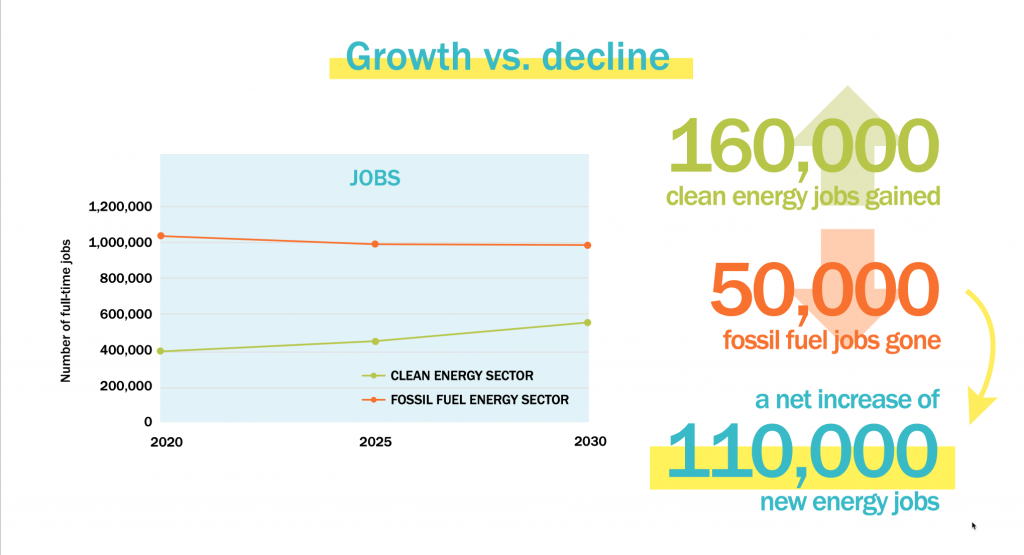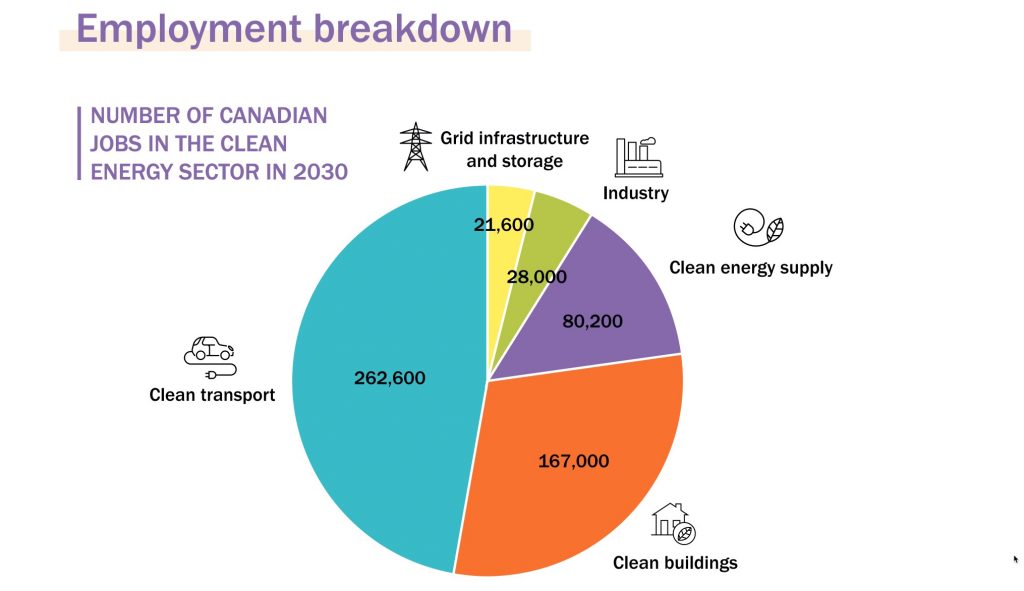
By David Dodge and Kay Rollans
“Often, good news doesn’t make the news,” Merran Smith, Executive Director of Clean Energy Canada, told Green Energy Futures. But when it comes to the green energy sector and climate solutions, Smith says there’s a lot of good news to talk about.
Smith’s organization, Clean Energy Canada, is a think tank that aims to accelerate the green energy transition in Canada. Through original research, they tell the story of sustainable energy solutions in Canada and around the world.
The story is one of success and innovation, and their research shows that the green energy transition transition will not only help Canada meet its climate goals, but will allow Canada build a strong, resilient, and growing economy.
Most Canadians say energy transition will benefit the economy
The world is going through a paradigm shift, leaving behind extractive and energy-consumptive economies in favour of clean energy production and energy efficiency. According to Smith, 70 per cent of Canadians already see the energy transition at play in Canada.
Smith and her organization have also found that most Canadians — about 75 per cent — are already on board with a strong energy transition plan. Nearly the same number believe that such a plan will ultimately benefit the country economically.
They have good reason to think so. There are indicators all over the world that economies, and therefore investments, are going green.
“We’re seeing cities in China that have 16,000 electric buses in one city,” says Smith. Corporations are also going green. In 2020, Ford, F 150 going electric, and Amazon has pledged to make half of its global shipments carbon neutral by 2030.
Support for the energy transition dips in Alberta, but Clean Energy Canada found that half of Albertans still understand that the energy transition is “not intended to harm Alberta’s oil sector workers, but it’s something intended to combat climate change,” said Smith.
What may end up harming oil sector workers most is postponing a decisive commitment to the energy transition, and Albertans understand this, too. Clean Energy Canada’s research shows that six out of 10 Albertans see global demand shifting away from oil and gas, and want Premier Jason Kenney to shift Alberta’s economy along with it. “They don’t want to see Alberta left behind,” said Smith.

Clean energy’s contributions by the numbers
As in any paradigm shift, it’s important to look beyond the costs on the old model and towards the opportunities of the new one. The transition to a green energy economy is no different.
“We see a lot of concern around one industry, the oil and gas industry, and what’s going to happen to that through the energy transition. But there isn’t a coherent story about the clean energy sector,” says Smith. And yet, there’s a lot to be said.
Across the board, clean energy is growing more quickly than the average growth of all sectors of the Canadian economy.
Take investment, for example. Investment in the clean energy sector has been increasing about twice as quickly as the rest of the economy. According to Smith, “investment grew from 21 billion in 2010 to 35.3 billion in 2017. So that’s an increase of almost 70 per cent.”
And those rates are only expected to increase. Bloomberg’s 2019 New Energy Outlook report predicted that of the $13.3 trillion that will be invested globally in energy generation in the next 30 years, 77% will be invested in renewable energy.
The clean energy sector’s contribution to GDP is also impressive. In Canada, it grew by 4.8 per cent between 2010 and 2017. As for the rest of the Canadian economy, “it only grew by 3.6 per cent over that same timeframe,” said Smith, who looked at the economic growth from clean energy in The Fast Lane” Tracking the Energy Revolution 2019.

In terms of jobs, 400,000 people are already employed in Canada’s clean energy sector today, and those numbers are growing fast. “We found that those jobs would grow up to over half a million, close to 600,000 jobs by 2030.” According to Smith, that means clean energy jobs in Canada are increasing at about four times the rate of other job sectors.
But who are these jobs for, anyway? “There’s a very, very large diversity of jobs,” says Smith. “They are all across Canada, every single province. They’re rural. They’re urban. They’re blue-collar jobs. They’re white-collar jobs.”
This is because the clean energy sector is much larger than we might, at first, imagine. “When people think of clean energy, they think of solar and wind, maybe hydro. So that’s one part of it is making clean energy,” Smith says, “but really, the bulk of the jobs are in wasting less energy.”

Largest solar project in Canadian history lands $500 million
There are some really exciting clean energy production projects on the go in Canada right now, and many of them — for instance, the Travers Solar Project, the largest solar project in the country — are right here in Alberta. The project just attracted $500 million in foreign investment.
Wind and solar are the cheapest ways to generate new electricity already, but attention is also focusing on electrifying transportation.
E-buses, planes and delivery vans
“Zero-emission transportation [is] coming on faster than we expected,” Smith explained, saying that Canada has some of the world’s leading electric bus producers: Lion in Quebec and New Flyer in Manitoba. Montreal ordered 40 electric buses from New Flyer and plans to go all electric by 2025. Edmonton has received two electric business and is expecting another 40 in 2020.

Meanwhile, the race to electrify delivery fleets is underway. Amazon has placed an order for 100,000 electric delivery vans from Rivian in Michigan and has also invested in the company. UPS has responded with an order for 10,000 electric delivery vans from Arrival in the UK.
Elsewhere in Canada, short-haul planes are going electric. “In British Columbia Harbor Air just ran a flight, an electric seaplane flight,” said Smith.

Greening and leaning buildings
Net-zero building is also booming throughout the country, as Green Energy Futures readers know. “Zero-emission houses … are cutting energy bills by 90 per cent,” said Smith. “We can really crack the affordability issue and carbon issue at the same time. We have the technology to build zero-emission buildings or near-zero-emission buildings, and that [also] means lower heating bills and lower electricity bills for people.”
Globally, we’re seeing the development of some really exciting net-zero building projects. In the Netherlands, for example, the EnergieSprong—an award-winning building retrofitting project aimed at upgrading 2 billion buildings to meet net-zero standards—has taken off, and now has teams working throughout Europe. The project has inspired similar initiatives in the United States and even pilot programs in Canada include one being carried out by net-zero pioneer Peter Amerongen at the Sundance Housing Coop in Edmonton.

And perhaps even more exciting, Edmonton has launched one of the most ambitious net-zero construction projects around: Blatchford, the largest carbon-neutral community in Canada. Blatchford has geothermal district energy, green building code and one builder is going all the way to net-zero right out of the starting gate.

Edmonton has been playing a leading role in other areas as well. Edmonton-based Enerkem is turning waste into a renewable fuel source.
“I’m excited that we’ve got both the technology to do these things and we’ve got the public will to move forward on these,” said Smith. “I think we’re having an interesting time in Canada where we could align the public’s interest in being a cleaner economy and being a leader in the global energy transition with some good government policy. And it would be a win-win-win for Canada.”
PHOTO OF UPS ELECTRIC DELIVERY VAN REMOVED. See link for a photo.
Green policy is profitable policy
Clean Energy Canada’s findings about job growth and investment in the clean energy sector are based on the Canadian federal and provincial climate policies currently in place. They asked, “What would happen if we fully implement just what’s here in Canada today?”
The answer is clear. Climate policy doesn’t have a negative impact on the economy, but a positive one. “Things like carbon pricing actually sends a signal to the investment community that investing in energy-efficient technologies is going to be a good investment here,” said Smith.
The important thing is that climate policy is strong and consistent. “We’ve actually seen the impact of this in a place like British Columbia that has had consistent climate policy over the last decade,” said Smith, adding that B.C.’s economy “has been the strongest economy in Canada or tied for the strongest economy in Canada over that time period.”
Unfortunately, consistent policy is a challenge in some parts of Canada, especially when governments flip-flop from one end of the political spectrum to the other. “What’s incredibly disruptive is to switch course and be moving in one direction then ripping up that policy when a new government comes in. In any sector that does not attract investment,” Smith explained.
Trillions are expected to be invested in the clean energy, buildings and transportation sectors over the next few decades. Many innovators across Canada are already working in the clean energy space but Smith says consistent policies are needed to attract the most investment.

Better, stronger, more consistent climate policy across the country will allow Canada to continue to be an economic leader in the global energy transition. Smith hopes that the federal government will set some clear, ambitious climate goals.
“You know, a million energy retrofits, 5,000 electric buses on the road, and so on. … It’s going to put us on a path to meet our climate targets,” Smith said. “It’s going to signal to investors in Canada what kind of investments are needed here. And the jobs and the companies will flow out of that.”
Merran Smith is the executive director of Clean Energy Canada, a think tank focused on accelerating the green energy transition in Canada by conducting original research and telling the story of the global shift to clean energy economies.

